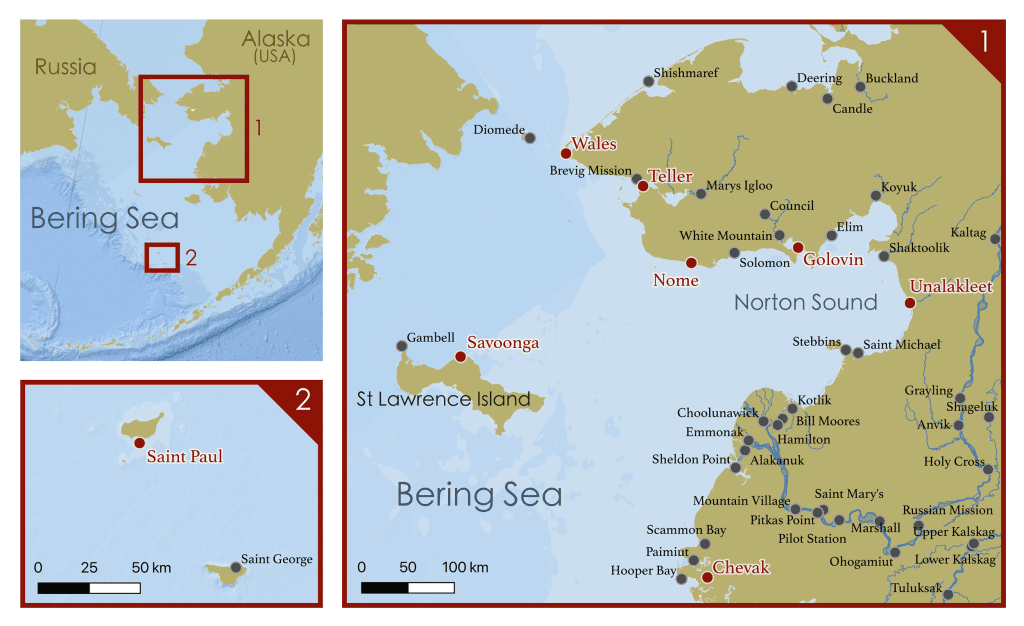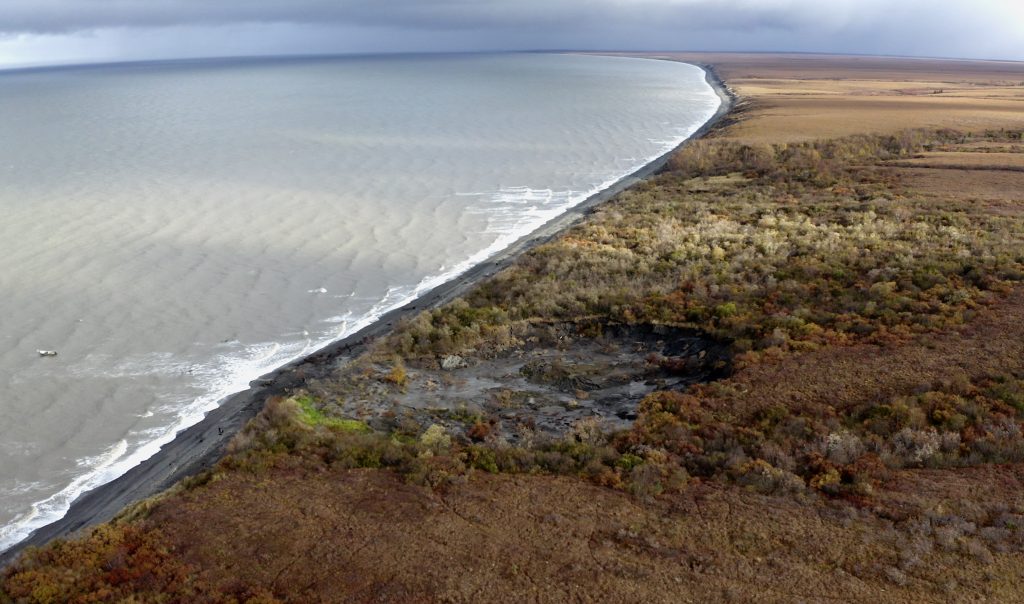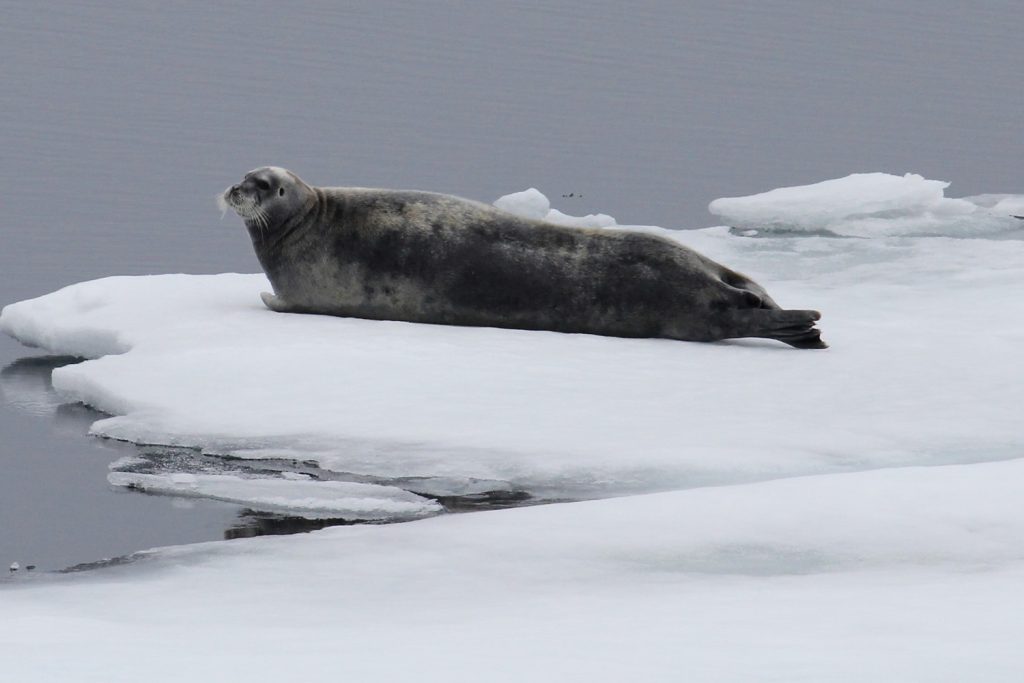An Indigenous Perspective for the 2019 Arctic Report Card
Richard Slats (from the community of Chevak), Carol Oliver (Golovin), Robert Bahnke (Nome), Helen Bell (Nome), Andrew Miller (Nome), Delbert Pungowiyi (Savoonga), Jacob Merculief (St. Paul Island), Norman Menadelook Sr. (Teller), Jerry Ivanoff (Unalakleet), and Clyde Oxereok (Wales)
M. L. Druckenmiller1, R. Daniel2, and M. Johnson3, Eds.
1National Snow and Ice Data Center, Boulder, CO, USA
2The Pew Charitable Trust, U.S. Arctic Program, Washington, D.C., USA
3Bering Sea Elders Group, Anchorage, AK, USA
Introduction
The Bering Sea is home to over 70 Indigenous communities of the Iñupiat, Central Yup’ik, Cup’ik, St. Lawrence Island Yupik, Unangan, and Chukchi Peoples. We are peoples of the world’s richest sea. We study the ocean and weather as a way of life, as a means for survival. The Bering Sea is undergoing changes that have never been observed in our lifetimes, but were foreseen by our elders decades ago. Global climate change is one of many forces beyond our control that are threatening the entire Bering Sea food chain, of which we are a part. Record-breaking temperatures, reductions in sea ice, and lack of snow are impacting our marine mammals, fish, seabirds, and ecosystem as a whole. The evidence exists along our coastlines, in our waters, and is revealed through the hardships we face in bringing harvests home to our families and communities.
Our resilience as Indigenous Peoples comes from our close proximity to the food resources that we depend on. In a warming Arctic, access to our subsistence foods is shrinking and becoming more hazardous to hunt and fish. At the same time, thawing permafrost and more frequent and higher storm surges increasingly threaten our homes, schools, airports, and utilities. Our environment has changed, but we remain vigilant. By adapting as we always have, we continue to hunt, fish, and harvest from the ocean and land. But, we fear for our young people; we worry that they will grow without the same foods and places that we have known throughout our lives. Maintaining what we inherited from our elders and thinking about our future generations, we offer this report as a glimpse into what we are observing and experiencing at the locations of our eight communities in the Bering Sea region of Alaska (Fig. 1).

An expanded version of this report with additional information and individual testimonials can be found at https://eloka-arctic.org/communities/bering-sea-voices.
Our changing world
Sea ice
We look for the return of the sea ice every fall season. Across our region, the ice provides access to seals, whales, walrus, fish, crabs, and other marine life for our subsistence harvests. Decades ago, we first saw the disappearance of the large floes of multiyear ice. This was the “mother ice” that would provide the big nails for securing our shorefast ice along the coast. Today, it is both the timing and overall thickness of the ice that has changed. Our sea ice arrives much later nowadays, with the largest shift occurring in the last five years (see essay Recent Warming in the Bering Sea). With a delayed and prolonged fall freeze-up, we are stranded for a growing part of the year when we can no longer use boats in the freezing waters, but also cannot yet safely travel across ice with snowmachines. Our traditional ice-based travel routes between communities (e.g., between Wales, Teller, and Brevig Mission) are no longer possible or are greatly limited in duration. At Diomede, a remote island community in the Bering Strait, the coastal sea ice has not been thick enough for an ice runway for the last 10 years or so, leaving the community to depend on less reliable helicopter access as their main means of resupply, mail delivery, and travel on and off the island throughout winter (e.g., to access health care and other social services). The warmer temperatures and delayed freeze-up also impact our river access. At Chevak, as in other coastal communities, the window of time for traveling our rivers and sloughs to set fish nets and traps is coming later, if it comes at all.
In the northern Bering Sea, sea ice used to be present with us for eight months a year. Today, we may only see three or four months with ice. We are used to generally assessing our ice thickness in feet, but now we are often looking at inches, even in the middle of winter. The anchored ridges of ice near our communities that we rely on to safely stabilize our shorefast ice are harder and harder to find, increasing the likelihood that storms or rising tides will break up and remove our ice throughout winter. This places at risk any stored fishing or hunting gear, including crab pots, that may be left on the ice for convenience and fuel-savings. At St. Lawrence Island, shorefast ice has been largely absent for the last five years. This lack of ice greatly hinders our ability to successfully hunt bowhead whales, which provide tons of meat and blubber for sharing throughout the island, as well as with other communities across the Bering Sea region and the whole state of Alaska. Walrus and seals are also no longer as reliably close to the island as they follow the drifting ice across greater distances. In particular, disruptions to our walrus hunting, which is a mainstay for the St. Lawrence Island Yupik, have a tremendous impact on our remote communities. The tomcod, which spawn under the island’s shorefast ice, are also moving to new locations. Further south, at St. Paul Island, we have not experienced sea ice in winter since 2013. The loss of sea ice has been the biggest change across our region, and with its loss there is nothing to keep our waters cold.
Winds and weather
One of the biggest dangers we face is that we are no longer able to reliably predict the weather, which is less stable now than in the past. In today’s world, we may see four weather patterns in a single day, typically with rapid shifts in wind direction. This limits our ability to spend time on the land or on the ocean (e.g., waiting for whales to come within chasing distance of our boats). It affects our planning and ability to collect and prepare our foods. For example, at Wales, due to more southerly winds in recent years (see essay Recent Warming in the Bering Sea), we see a change in when our clams show up; we used to harvest them in fall but now we do so in summer.
We are also experiencing changes in our precipitation—primarily less snow in winter, more frequent winter rain events, and wetter summers. The winter snow is needed to fill our creeks for safe crossings, to keep our ptarmigan nearby through providing shelter as they burrow and eat willows throughout the cold months, and to provide for bountiful salmon berry harvests in summer. Winter rains coat our runways in ice and prevent the planes from landing in our communities, the vast majority of which are not connected to road systems. At Nome, as we travel back and forth to our fish camps in summer, wetter weather with more unpredictable and heavy rains leaves us fewer days to dry our fish. As a result, we are increasingly using roofs (or hootches) over our fish drying racks. This past year’s unusually warm air and water temperatures may also be linked to greater weeds seen in our lagoons. At Safety Lagoon near Nome, weeds rising through the water were clogging boat engines as we traveled to our cabins in summer.
Storms and erosion
Warning signs are found all around us of the challenges we face with our eroding shorelines and thawing permafrost. We are seeing coastal landslides, large sinkholes (Fig. 2), and methane bubbling up through our ponds in summer. Thawing permafrost combined with more frequent and higher storm surges, made possible by the diminishing sea ice, is threatening our roads, runways, schools, homes, fish camps, and utilities that carry our water and sewage. This strikes at the heart of our safety, health, and economic well-being. In Golovin, where many community members fish commercially, our only fish processing plant is falling into the ocean. We know that these types of losses are often only a matter of time, but there is also a lot that we still have time to protect. We are encouraging our young people to build on higher ground.

Observing our animals
Multiple causes for concern
The ocean is our garden. As our well-being relies on the health of this garden, we observe the cumulative impacts on our food resources. The stresses of climate change are a major concern, yet we cannot necessarily separate those from the detrimental impacts that contamination and pollution also have had on our ocean, land, and air, and thereby on the animals and plants that sustain us. We acknowledge the risks that we continue to face as a legacy of the buried military materials around our communities (e.g., fuel drums that are rotting in the tundra), the past use of polychlorinated biphenyls (PCBs) and dichlorodiphenyltrichloroethane (DDT) on our lands, the bio-accumulation of mercury in our marine mammals, and the distant nuclear disasters of Chernobyl (1986) and Fukushima (2011). As we find black blisters on harvested tomcod, observe abnormal odors from the guts of harvested seals, unusual hair-loss on our ugruks (bearded seals, Fig. 3), or animals acting strangely with an extraordinary willingness to approach people, we are reminded that both local and global sources of contamination remain a very long-lived threat that has come to reside in Arctic ecosystems. Our ocean also brings garbage from all over the world. We find plastics as we dissect dead fish and birds found on our beaches. We increasingly must guard against plastic bags being sucked into boat engines. Styrofoam and lost fishing equipment are continually deposited up and down our coastlines.

Fish
The fisheries of the Bering Sea are vital to our food security and economic well-being. We harvest fish from our rivers, from the sea ice, and in the open ocean. As the temperatures of ocean waters rise and winter sea ice diminishes, the health of our fisheries is of growing concern. At Teller and Nome, we have seen die-offs of our blue cod and tomcod, likely due to lack of food. During this past summer’s record-breaking heat wave, large numbers of salmon were washing up dead along the Ninglikfak River near Chevak, the Kuskokwim River, and other waters across our region. We also see changes in fish migration timing and patterns (see essays Recent Warming in the Bering Sea and Bering Sea Fisheries). With a later fall freeze-up and an earlier spring thaw, the salmon runs are changing, requiring us to adjust when we fish. Some salmon are traveling further north altogether to spawn in colder waters.
Marine mammals
The media and scientific coverage of massive seal die-offs in Alaskan waters is confirmed by what we too observe. At Wales, we counted 20 dead young ugruks from this past spring that had presumably not had enough food. Similarly, on St. Lawrence Island, we observed 50 dead spotted seals and young ugruks along a 15-20 mile stretch of beach. In recent years, near Chevak, various species of seals with bald patches have been found floating dead on our rivers. While the messages we receive from biologists point to starvation, as opposed to disease, these observations are nonetheless alarming and cause worry regarding the security and safety of our food sources. With sea ice diminishing, our walruses, ugruks, whales, and polar bears are in danger. Our whole marine ecosystem is in danger, threatening our traditional way of life.
Birds
Our seabird populations are also under threat due to a lack of food associated with the rising temperatures of our waters. We have regularly observed die-offs during at least the last five summers. Around Wales, we have found our beaches littered with dead eider ducks, murres, and auklets. St. Lawrence Island experienced a massive auklet die-off this past summer. The adults laid their eggs but abandoned their chicks soon after they hatched. It was the adults’ survival strategy in the absence of food. Still, we found dead adult auklets across our beaches, which necropsies confirmed had empty stomachs. Similarly, at Chevak this past summer, we observed common murres that were unable to fly because they were too hungry. Our little birds are also indicators of change, and we see these less and less. The lack of songbirds around Nome and Wales has brought uncommon silence when we are out on the land.
Looking to the future
We are sharing today things similar to what our elders shared in the past. We have seen change coming. Now, we know it is here. When we were young, we learned to read the clouds to understand the weather. We laid on the ground for hours with our grandparents, looking upwards. It is difficult to pass on this knowledge when the subject of our study is changing so quickly. The world from our childhood is no longer here. Our young children today are seeing so much change, but it is difficult for them to understand the pace. We are losing so much of our culture and connections to the resources from our ocean and lands. Store-bought groceries and meat, which are flown in by airplane at great cost, are continually replacing our local, fresh and nutritious subsistence foods. Our food security is even more at risk as our young people increasingly face high rates of unemployment with few job opportunities, and are less likely to own a boat for hunting and fishing.
With the unprecedented retreat of sea ice, expected increases in marine traffic and expanding fisheries are only more likely to further stress our Bering Sea ecosystem. We already are experiencing an increase in the number of large cargo ships entering our waters, as well as the growing prospects of harmful mining along our rivers. What steps will we take to care for our environment, to conserve, and to spark real action to address climate change? Our children need to be prepared to respond to these questions. It is therefore vital that our young people participate in this process of documenting and sharing our observations of change and adaptation across our region.
Afterword and acknowledgments
This essay is a direct result of a workshop in Nome, Alaska, during 26-27 September 2019, when ten elders from eight communities met for two days of sharing and discussion (Fig. 4). Many of us have never had a chance to share our voices to such a report. We are grateful for this opportunity to contribute to the NOAA Arctic Report Card. We also acknowledge that our eight communities are few compared to the total number in our region. While the peoples of the Bering Sea are experiencing many of the same challenges related to climate and environmental change, each community exists within its unique location and has its own experiences.

We thank the Study of Environmental Arctic Change (SEARCH) and the National Snow and Ice Data Center (NSIDC) that funded and supported the workshop. We are very grateful to the University of Alaska Fairbanks (UAF) Northwest Campus in Nome, Alaska, for hosting the workshop; we specifically thank Barb QasuGlana Amarok and Mariah Morgan for their assistance. Lastly, this report would not have been possible without the support of the tribal councils of Chevak, Golovin, Savoonga, St. Paul Island, Teller, Unalakleet, and Wales, and the coordination provided by the Bering Sea Elders Group and Pew Charitable Trusts.
November 22, 2019